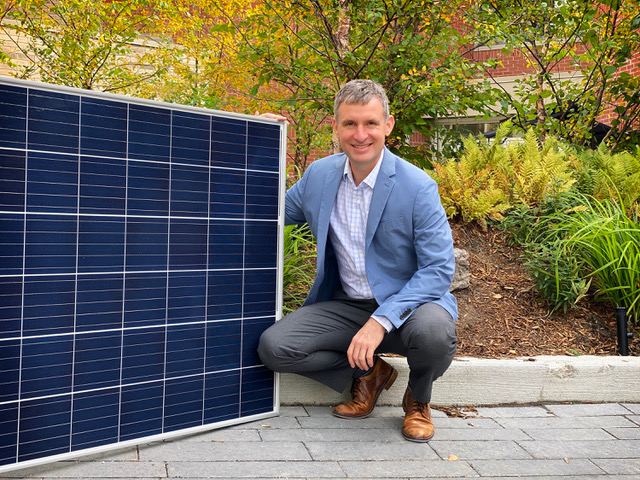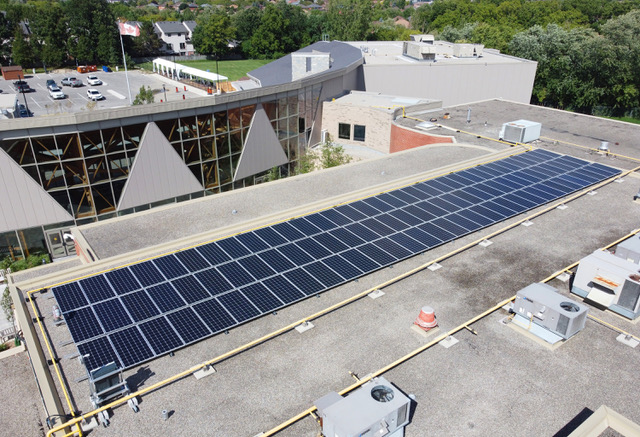On an unusually bright fall day in October, TMS Head of School David Young announced to his school community that it wouldn’t just be sunshine streaming into the classrooms of the Upper and Lower School campuses, but sustainably generated energy from the newly installed solar panels spanning the gymnasium roofs.

David Young
“As a School operating in 2020, we recognize that we don’t just have an opportunity, but a duty to make sustainability and a focus on the environment a key pillar in all the work that we do,” said Young. “How can we call ourselves a leading school in this day and age without doing that work?”
Offsetting approximately 20% of the school’s energy costs, the significant bank of panels at each of the school’s campuses (installed over the summer of 2020) also feature a live-time portal that teachers and students can log in to and use the data for projects and classroom work. “We wanted to ensure that these weren’t just panels that got installed and forgotten about, but that they became interactive tools for a variety of subjects that could be used to study energy use and conservation in the real world,” said Young.

DCIM100MEDIADJI_0039.JPG
This investment in solar energy, supported by donations from the School Community over the course of the 2019 – 2020 academic year, came at a time when TMS was recognizing the unique opportunity the School had to be leaders in the integration of education and sustainability—working towards a future in which schools seamlessly balance a commitment to our students with a commitment to the world in which we live.
“TMS had just finished an extensive capital expansion to our Lower School where sustainability had become the cornerstone from which everything else cascaded,” said Mr. Young. “From energy use, right through to building materials, we wanted to create a space that was inspiring in how it looked and felt, but also in the values it represented. Sustainably sourced Canadian wood was used throughout this new building, each cubic metre of which stores about one tonne of carbon dioxide. That means the building itself has the impact of removing the equivalent of approximately twenty-seven cars from the road each year in terms of embodied carbon. It’s a beautiful marriage of aesthetic vision and health-focused design with environmental responsibility and that made us look at additional ways we could continue to bring sustainability into other aspects of the school.”
The school is working on a comprehensive sustainability strategy that will encompass everything from curriculum, to policies, to continued building expansion, to day-to-day operations, often inspired by its own students.
When a TMS Grade 10 student embarked on a project last year entitled “The Last Straw,” studying the damage that single-use plastics are having on the environment, it stoked her already existing passion for sustainability. “Plastic pollution has contributed significantly to the deteriorating health of our planet, and single-use plastic products are a major contributor to this negative impact,” said the student. “It was in researching this topic that led me to explore a number of producers to learn the process and innovative alternatives available”. She found a plant-based alternative to plastic that can be used for cups, utensils, plates, bowls, and take-away containers which led her to start her own small business, bringing these products to organizations—one of which was TMS. “The key will always be to offer high-quality effective sustainable types of products at prices people can afford so that there is no need to think twice about making the right choice,” said the student. The school was so impressed with her entrepreneurial initiative that she was invited to pitch her alternative and, as a result, her products were piloted for operational use through the year.
Another student in the elementary program brought her passion for the conservation of monarch butterflies to the school and, with her family, advocated for turning the newly created outdoor learning space (part of the new building expansion) into an official Monarch Waystation. TMS embraced the opportunity and the student worked to plant butterfly friendly flowers, provided educational signage, and even brought recently hatched butterflies (raised in her home) to release into the space with her classmates so that others could share her passion for monarch preservation.
TMS is also identifying opportunities for integrating sustainability into its broader curriculum and special programming for students. The topic became the foundation on which a number of programs were built for different ages and stages, the most recent being a university-based Entrepreneurial and Innovation Experience for Grade 9 and 10 students. Using the framework of the UN Sustainable Development Goals as a starting point, the program challenges students to create entrepreneurial solutions to real-life problems (like climate action, clean water, affordable renewable energy, etc.). Although the program was postponed this year due to COVID, there is a continued focus at all levels of the school to integrate sustainability into the Montessori and IB curriculum.
“The more opportunities we as a school can advocate for sustainability initiatives and lead by example, the more we see these types of ideas flourish in our students. They know that they have the support of an entire school community behind them to suggest ideas and test them out in a safe-fail environment,” said Mr. Young. “The installation of our new solar panels is an incredibly exciting step that the school was eager to make, but it’s just that—one step in what we hope will become a seamless journey into creating a school-wide sustainability strategy that informs every aspect of what we do.”
ABOUT THE AUTHOR
Dionne M. Malcolm is the Director of Strategic Communications and Marketing at TMS—a multi-campus, Toddler to Grade 12 leading Independent School in Richmond Hill, Ontario that seamlessly combines the Montessori and International Baccalaureate programs for its 800 students.
This article is from Canadian Teacher Magazine’s online article offerings for Fall 2020.









